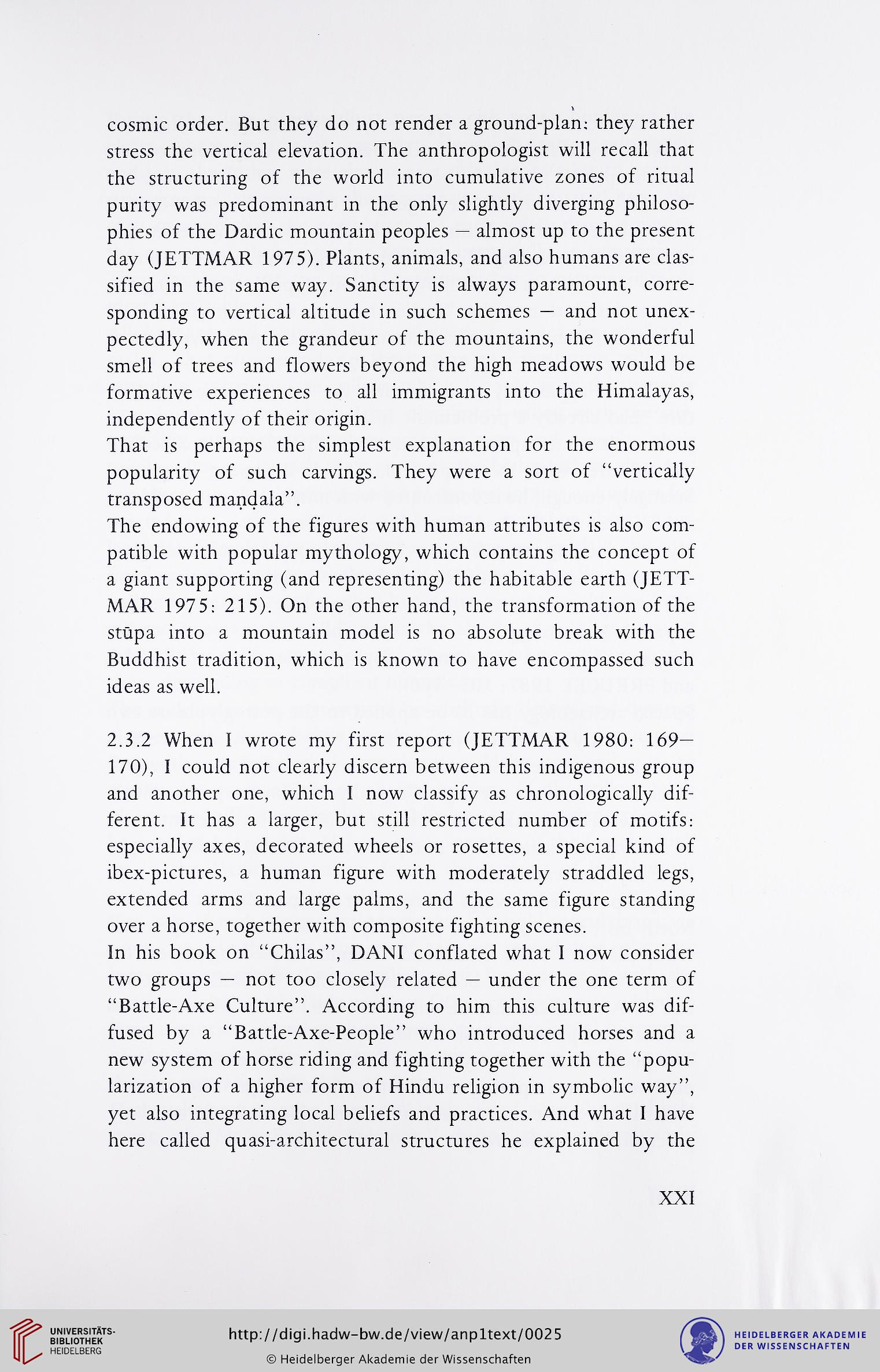cosmic order. But they do not render a ground-plan; they rather
stress the vertical elevation. The anthropologist will recall that
the structuring of the world into cumulative zones of ritual
purity was predominant in the only slightly diverging philoso-
phies of the Dardic mountain peoples — almost up to the present
day (JETTMAR 1975). Plants, animals, and also humans are clas-
sified in the same way. Sanctity is always paramount, corre-
sponding to vertical altitude in such schemes — and not unex-
pectedly, when the grandeur of the mountains, the wonderful
smell of trees and flowers beyond the high meadows would be
formative experiences to all immigrants into the Himalayas,
independently of their origin.
That is perhaps the simplest explanation for the enormous
popularity of such carvings. They were a sort of "vertically
transposed mandala".
The endowing of the figures with human attributes is also com-
patible with popular mythology, which contains the concept of
a giant supporting (and representing) the habitable earth (JETT-
MAR 1975: 215). On the other hand, the transformation of the
stupa into a mountain model is no absolute break with the
Buddhist tradition, which is known to have encompassed such
ideas as well.
2.5.2 When 1 wrote my first report (JETTMAR 1980: 169—
170), I could not clearly discern between this indigenous group
and another one, which I now classify as chronologically dif-
ferent. It has a larger, but still restricted number of motifs:
especially axes, decorated wheels or rosettes, a special kind of
ibex-pictures, a human figure with moderately straddled legs,
extended arms and large palms, and the same figure standing
over a horse, together with composite fighting scenes.
In his book on "Chilas", DANI conflated what I now consider
two groups — not too closely related — under the one term of
"Battle-Axe Culture". According to him this culture was dif-
fused by a "Battle-Axe-People" who introduced horses and a
new system of horse riding and fighting together with the "popu-
larization of a higher form of Hindu religion in symbolic way",
yet also integrating local beliefs and practices. And what I have
here called quasi-architectural structures he explained by the
XXI
stress the vertical elevation. The anthropologist will recall that
the structuring of the world into cumulative zones of ritual
purity was predominant in the only slightly diverging philoso-
phies of the Dardic mountain peoples — almost up to the present
day (JETTMAR 1975). Plants, animals, and also humans are clas-
sified in the same way. Sanctity is always paramount, corre-
sponding to vertical altitude in such schemes — and not unex-
pectedly, when the grandeur of the mountains, the wonderful
smell of trees and flowers beyond the high meadows would be
formative experiences to all immigrants into the Himalayas,
independently of their origin.
That is perhaps the simplest explanation for the enormous
popularity of such carvings. They were a sort of "vertically
transposed mandala".
The endowing of the figures with human attributes is also com-
patible with popular mythology, which contains the concept of
a giant supporting (and representing) the habitable earth (JETT-
MAR 1975: 215). On the other hand, the transformation of the
stupa into a mountain model is no absolute break with the
Buddhist tradition, which is known to have encompassed such
ideas as well.
2.5.2 When 1 wrote my first report (JETTMAR 1980: 169—
170), I could not clearly discern between this indigenous group
and another one, which I now classify as chronologically dif-
ferent. It has a larger, but still restricted number of motifs:
especially axes, decorated wheels or rosettes, a special kind of
ibex-pictures, a human figure with moderately straddled legs,
extended arms and large palms, and the same figure standing
over a horse, together with composite fighting scenes.
In his book on "Chilas", DANI conflated what I now consider
two groups — not too closely related — under the one term of
"Battle-Axe Culture". According to him this culture was dif-
fused by a "Battle-Axe-People" who introduced horses and a
new system of horse riding and fighting together with the "popu-
larization of a higher form of Hindu religion in symbolic way",
yet also integrating local beliefs and practices. And what I have
here called quasi-architectural structures he explained by the
XXI




